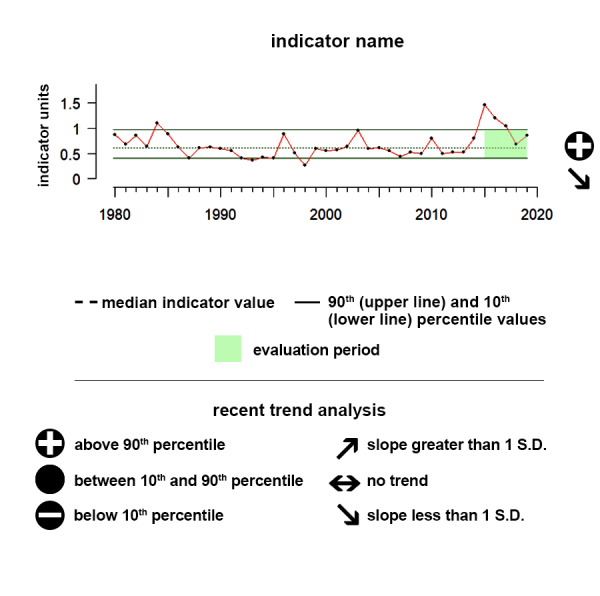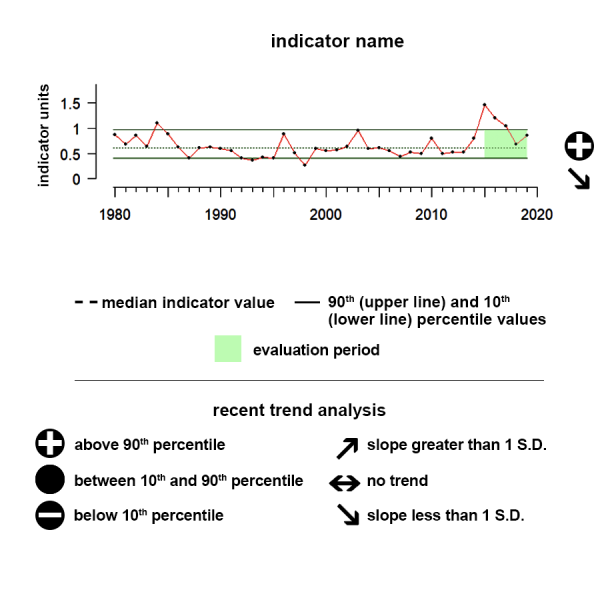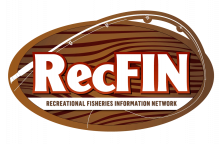
Description of Recreational Fishing (Effort and Harvest):
U.S. saltwater recreational fishing is an important source of seafood, jobs, and recreation for millions of anglers and for-hire recreational businesses. Recreational fishing effort is measured as “Angler Trips”, which is the number of recreational fishing trips people go on. Recreational fishing harvest is the number of fish caught and brought to shore on recreational fishing trips.
Recreational effort and harvest help us understand how recreational opportunities and seafood derived from our marine environment is changing over time. Fisheries managers use this data to set annual catch limits and fishing regulations, including season lengths, size, and daily catch limits. We present the total number of fish harvested and angler trips annually for all marine fish in all regions.
Data Source:
Recreational harvest and effort data pulled from National Summary Query at https://www.st.nmfs.noaa.gov/recreational-fisheries/data-and-documentation/queries/index. Units of data are Effort in Angler Trips and Harvest in numbers of fish.
For the most up to date data, please visit the original source linked above.
Understanding the Time series plots
Time series plots show the changes in each indicator as a function of time, over the period 1980-present. Each plot also shows horizontal lines that indicate the median (middle) value of that indicator, as well as the 10th and 90th percentiles, each calculated for the entire period of measurement. Time series plots were only developed for datasets with at least 10 years of data. Two symbols located to the right of each plot describe how recent values of an indicator compare against the overall series. A black circle indicates whether the indicator values over the last five years are on average above the series 90th percentile (plus sign), below the 10th percentile (minus sign), or between those two values (solid circle). Beneath that an arrow reflects the trend of the indicator over the last five years; an increase or decrease greater than one standard deviation is reflected in upward or downward arrows respectively, while a change of less than one standard deviation is recorded by a left-right arrow.

Alaska Recreational Effort
Between 2016 and 2021, recreational fishing effort from Alaska is around historic levels. There is no significant trend apparent.
Values correspond to cumulative number of angler trips
Description of time series:
Between 2016 and 2021, recreational fishing effort from Alaska is around historic levels. There is no significant trend apparent.
Indicator Source Information
Recreational harvest and effort data pulled from National Summary Query. Units of data are in Effort in Angler Trips and Harvest in numbers of fish. The data from these queries is used by state, regional and federal fisheries scientists and managers to maintain healthy and sustainable fish stocks.
Data Background and Caveats:
To properly interpret this information, it is important to consider the following key points:
- When comparing harvest estimates across an extended time series, note differences in sampling coverage through the years. Some estimates may not be comparable over long time series.
- Changes may occur between preliminary and final estimates and year to year, meaning that the data may change when updated. Please review the Limitations and other sections on the Using the Data page from the source for more information.
Hawai'i Recreational Effort
Between 2017 and 2022, average recreational fishing effort in the Hawaiʻi-Pacific Islands is around historic levels although the most recent three years present the highest effort in the historical series and shows a significant upward trend.
Values correspond to cumulative number of angler trips
Description of time series:
Between 2017 and 2022, average recreational fishing effort in the Hawaiʻi-Pacific Islands is around historic levels although the most recent three years present the highest effort in the historical series and shows a significant upward trend.
Indicator Source Information
Recreational harvest and effort data pulled from National Summary Query. Units of data are in Effort in Angler Trips and Harvest in numbers of fish.The data from these queries is used by state, regional and federal fisheries scientists and managers to maintain healthy and sustainable fish stocks.
Data Background and Caveats:
To properly interpret this information, it is important to consider the following key points:
- When comparing harvest estimates across an extended time series, note differences in sampling coverage through the years. Some estimates may not be comparable over long time series.
- Changes may occur between preliminary and final estimates and year to year, meaning that the data may change when updated. Please review the Limitations and other sections on the Using the Data page from the source for more information.
California Current Recreational Effort
Between 2017 and 2022, recreational fishing effort in California Current is similar to historic levels and shows no trend.
Values correspond to cumulative number of angler trips
Description of time series:
Between 2017 and 2022, recreational fishing effort in California Current is similar to historic levels and shows no trend.
Indicator Source Information
Recreational harvest and effort data pulled from National Summary Query. Units of data are in Effort in Angler Trips and Harvest in numbers of fish.The data from these queries is used by state, regional and federal fisheries scientists and managers to maintain healthy and sustainable fish stocks.
Data Background and Caveats:
To properly interpret this information, it is important to consider the following key points:
- When comparing harvest estimates across an extended time series, note differences in sampling coverage through the years. Some estimates may not be comparable over long time series.
- Changes may occur between preliminary and final estimates and year to year, meaning that the data may change when updated. Please review the Limitations and other sections on the Using the Data page from the source for more information.
Gulf of America Recreational Effort
Between 2017 and 2022, recreational fishing effort in the Gulf of America is around historic levels. There is no trend apparent.
Values correspond to cumulative number of angler trips
Description of time series:
Between 2017 and 2022, recreational fishing effort in the Gulf of America is around historic levels. There is no trend apparent.
Indicator Source Information
Recreational harvest and effort data pulled from National Summary Query. Units of data are in Effort in Angler Trips and Harvest in numbers of fish. The data from these queries is used by state, regional and federal fisheries scientists and managers to maintain healthy and sustainable fish stocks.
Data Background and Caveats:
To properly interpret this information, it is important to consider the following key points:
- When comparing harvest estimates across an extended time series, note differences in sampling coverage through the years. Some estimates may not be comparable over long time series.
- Changes may occur between preliminary and final estimates and year to year, meaning that the data may change when updated. Please review the Limitations and other sections on the Using the Data page from the source for more information.
Southeast Recreational Effort
Between 2017 and 2022, recreational fishing effort in Southeast is around historic levels and shows no trend.
Values correspond to cumulative number of angler trips
Description of time series:
Between 2017 and 2022, recreational fishing effort in Southeast is around historic levels and shows no trend.
Indicator Source Information
Recreational harvest and effort data pulled from National Summary Query. Units of data are in Effort in Angler Trips and Harvest in numbers of fish.The data from these queries is used by state, regional and federal fisheries scientists and managers to maintain healthy and sustainable fish stocks.
Data Background and Caveats:
To properly interpret this information, it is important to consider the following key points:
- When comparing harvest estimates across an extended time series, note differences in sampling coverage through the years. Some estimates may not be comparable over long time series.
- Changes may occur between preliminary and final estimates and year to year, meaning that the data may change when updated. Please review the Limitations and other sections on the Using the Data page from the source for more information.
Northeast Recreational Effort
Between 2017 and 2022, recreational fishing effort in the Northeast is around historic levels and shows no trend.
Values correspond to cumulative number of angler trips
Description of time series:
Between 2017 and 2022, recreational fishing effort in the Northeast is around historic levels and shows no trend.
Indicator Source Information
Recreational harvest and effort data pulled from National Summary Query. Units of data are in Effort in Angler Trips and Harvest in numbers of fish. The data from these queries is used by state, regional and federal fisheries scientists and managers to maintain healthy and sustainable fish stocks.
Data Background and Caveats:
To properly interpret this information, it is important to consider the following key points:
- When comparing harvest estimates across an extended time series, note differences in sampling coverage through the years. Some estimates may not be comparable over long time series.
- Changes may occur between preliminary and final estimates and year to year, meaning that the data may change when updated. Please review the Limitations and other sections on the Using the Data page from the source for more information.
Alaska Recreational Harvest
Between 2017 and 2021, recreational harvest from Alaska are around historic levels, although 2020 presents the lowest level of effort for the entire series. There is no trend apparent.
Values correspond to harvest in millions of fish
Description of time series:
Between 2017 and 2021, recreational harvest from Alaska are around historic levels, although 2020 presents the lowest level of effort for the entire series. There is no trend apparent.
Indicator Source Information
Recreational harvest and effort data pulled from National Summary Query. Units of data are in Effort in Angler Trips and Harvest in numbers of fish.The data from these queries is used by state, regional and federal fisheries scientists and managers to maintain healthy and sustainable fish stocks.
Data Background and Caveats:
To properly interpret this information, it is important to consider the following key points:
- When comparing catch estimates across an extended time series, note differences in sampling coverage through the years. Some estimates may not be comparable over long time series.
- Changes may occur between preliminary and final estimates and year to year, meaning that the data may change when updated. Please review the Limitations and other sections on the Using the Data page from the source for more information.
Hawai'i Recreational Harvest
Between 2017 and 2022, recreational harvest from Hawaii are around historic levels. There is no trend apparent.
Values correspond to harvest in millions of fish
Description of time series:
Between 2017 and 2022, recreational harvest from Hawaii are around historic levels. There is no trend apparent.
Indicator Source Information
Recreational harvest and effort data pulled from National Summary Query. Units of data are in Effort in Angler Trips and Harvest in numbers of fish.The data from these queries is used by state, regional and federal fisheries scientists and managers to maintain healthy and sustainable fish stocks.
Data Background and Caveats:
To properly interpret this information, it is important to consider the following key points:
- When comparing catch estimates across an extended time series, note differences in sampling coverage through the years. Some estimates may not be comparable over long time series.
- Changes may occur between preliminary and final estimates and year to year, meaning that the data may change when updated. Please review the Limitations and other sections on the Using the Data page from the source for more information.
California Current Recreational Harvest
Between 2017 and 2021, recreational harvest from California Current are below historic levels, and 2020 levels are around historic lows for the series. There is no significant trend apparent.
Values correspond to harvest in millions of fish
Description of time series:
Between 2017 and 2021, recreational harvest from California Current are below historic levels, and 2020 levels are around historic lows for the series. There is no significant trend apparent.
Indicator Source Information
Recreational harvest and effort data pulled from National Summary Query. Units of data are in Effort in Angler Trips and Harvest in numbers of fish.The data from these queries is used by state, regional and federal fisheries scientists and managers to maintain healthy and sustainable fish stocks.
Data Background and Caveats:
To properly interpret this information, it is important to consider the following key points:
- When comparing catch estimates across an extended time series, note differences in sampling coverage through the years. Some estimates may not be comparable over long time series.
- Changes may occur between preliminary and final estimates and year to year, meaning that the data may change when updated. Please review the Limitations and other sections on the Using the Data page from the source for more information.
Gulf of America Recreational Harvest
Between 2017 and 2022, recreational harvest from the Gulf of America are around historic levels, though the 2020 level is the lowest of the series. There is no trend apparent.
Values correspond to harvest in millions of fish
Description of time series:
Between 2017 and 2022, recreational harvest from the Gulf of America are around historic levels, though the 2020 level is the lowest of the series. There is no trend apparent.
Indicator Source Information
Recreational harvest and effort data pulled from National Summary Query. Units of data are in Effort in Angler Trips and Harvest in numbers of fish. The data from these queries is used by state, regional and federal fisheries scientists and managers to maintain healthy and sustainable fish stocks.
Data Background and Caveats:
To properly interpret this information, it is important to consider the following key points:
- When comparing catch estimates across an extended time series, note differences in sampling coverage through the years. Some estimates may not be comparable over long time series.
- Changes may occur between preliminary and final estimates and year to year, meaning that the data may change when updated. Please review the Limitations and other sections on the Using the Data page from the source for more information.
Southeast Recreational Harvest
Between 2017 and 2022, recreational harvest from Southeast are around historic levels. There is no significant trend apparent.
Values correspond to harvest in millions of fish
Description of time series:
Between 2017 and 2022, recreational harvest from Southeast are around historic levels. There is no significant trend apparent.
Indicator Source Information
Recreational harvest and effort data pulled from National Summary Query. Units of data are in Effort in Angler Trips and Harvest in numbers of fish.The data from these queries is used by state, regional and federal fisheries scientists and managers to maintain healthy and sustainable fish stocks.
Data Background and Caveats:
To properly interpret this information, it is important to consider the following key points:
- When comparing catch estimates across an extended time series, note differences in sampling coverage through the years. Some estimates may not be comparable over long time series.
- Changes may occur between preliminary and final estimates and year to year, meaning that the data may change when updated. Please review the Limitations and other sections on the Using the Data page from the source for more information.
Northeast Recreational Harvest
Between 2017 and 2022, recreational harvest from Northeast are around historic levels. There is no significant trend apparent.
Values correspond to harvest in millions of fish
Description of time series:
Between 2017 and 2022, recreational harvest from Northeast are around historic levels. There is no significant trend apparent.
Indicator Source Information
Recreational harvest and effort data pulled from National Summary Query. Units of data are in Effort in Angler Trips and Harvest in numbers of fish. The data from these queries is used by state, regional and federal fisheries scientists and managers to maintain healthy and sustainable fish stocks.
Data Background and Caveats:
To properly interpret this information, it is important to consider the following key points:
- When comparing catch estimates across an extended time series, note differences in sampling coverage through the years. Some estimates may not be comparable over long time series.
- Changes may occur between preliminary and final estimates and year to year, meaning that the data may change when updated. Please review the Limitations and other sections on the Using the Data page from the source for more information.
RecFin
Established in 1992, the Pacific Coast Recreational Fisheries Information Network is designed to integrate state and federal marine recreational fishery sampling efforts into a single database to provide important biological, social, and economic data for Pacific coast recreational fishery biologists, managers and anglers.
The three Interstate Marine Fishery Commissions are critical to managing and conserving our shared coastal fisheries within the first three miles of the nation’s coastline. The Commissions were formed as interstate compacts by the coastal states of the Atlantic, Pacific and Gulf of Mexico and chartered by the United States Congress in recognition that “fish do not adhere to political boundaries.” The Commissions serve as a deliberative body, coordinating the conservation and management of the states shared near-shore fishery resources – marine, shell, and anadromous – for sustainable use.

